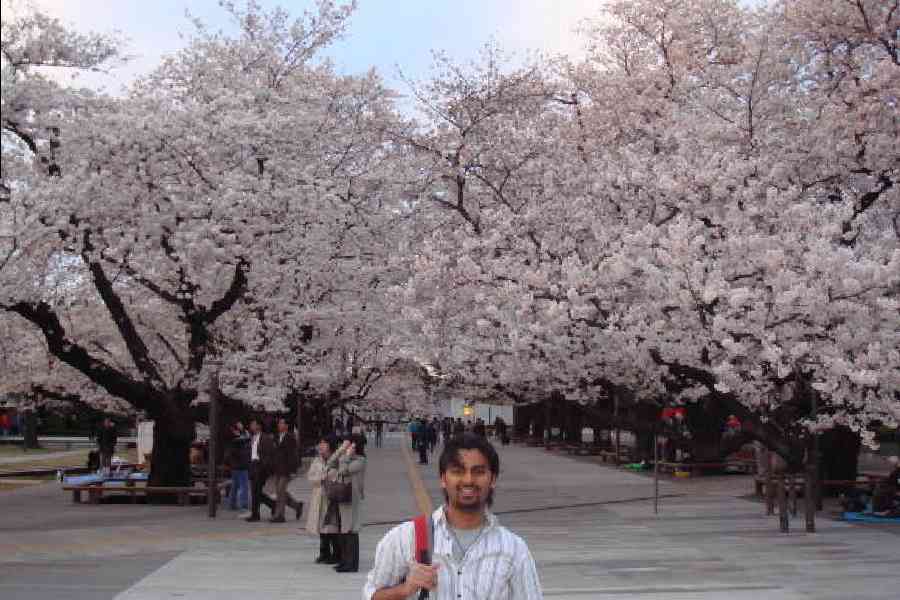What’s MEXT


A fortnight after she had landed in Japan, Ahana Basak, a medicinal chemist, posted on LinkedIn: “I am delighted to announce that I have commenced my journey as a research student in the department of pharmaceutical sciences of the prestigious University of Osaka in Japan. This new chapter presents an exciting opportunity to delve into cutting edge research in nucleic acid chemistry…”
She had been a senior research biologist at TCG Life Sciences, a pharmaceutical company in Calcutta, for three years after having finished her master’s in medicinal chemistry from the National Institute of Pharmaceutical Education and Research (Niper) at Mohali, Punjab.
Anisha Ghosh, who is a computer science engineer at an Amsterdam-based company, landed in Japan two weeks ago. She is pursuing a master’s in technology with specialisation in cybersecurity. She completed her BTech from VIT-AP University in Andhra Pradesh in 2024.
Abhronil Adhikari is also in Japan to pursue a master’s degree in information science and electronic engineering. He is a fresh graduate in electronics and communications engineering from NIT Kurukshetra.
All three youngsters are Monbukagakusho or Mext scholars. They cracked the fully-funded 2025 scholarship programme offered by the ministry of education, culture, sports, science and technology (Mext) of Japan to international students.
Sometime in late March, they had congregated for a pre-departure orientation at the office of the consulate general of Japan in Calcutta. The orientation included a primer on Japanese culture and customs and a presentation by a former Mext scholar, Farhan Nawaz (see pic).
Nawaz first went to Japan in 2004 on a five-year scholarship. After a year of intensive Japanese language training at the Tokyo University of Foreign Studies, he pursued a BTech in information engineering at the Tokyo Institute of Technology. He later earned an MTech in communications and integrated systems under an extended Mext scholarship. By 2011, Nawaz had landed a job as a web developer at Rakuten, an e-commerce giant based in Japan.
Reflecting on his journey, he told The Telegraph, “Indian students flock to the US, Canada and Europe, but they are simply not aware of the study opportunities nor the huge job market for qualified IT professionals in Japan.”
Nawaz moved back to India and worked first at Mitsubishi Corporation India, then Nomura Research Institute Financial Technologies India. In 2021, Nomura transferred him to Calcutta. A year ago, he founded a Calcutta-based IT consulting company, Kyokan Infotech Pvt. Ltd. The name “Kyokan” comes from a Japanese word meaning empathy. Kyokan Infotech aims to support small and medium-sized enterprises (SMEs) in Japan with digital transformation (DX) and web development services.
“DX initiatives in Japan are lagging behind due to a shortage of IT talent. On the other hand, there is a huge DX talent pool in India that is growing every year. There’s ample opportunity to accelerate the DX initiatives of Japanese companies by leveraging Indian IT talent,” says Nawaz.
Acting consul general Ashida Katsunori said the Mext scholarship is a gateway for international students to higher education institutes in Japan. “The purpose of these scholarship programmes is to accept excellent human resources from foreign countries, including India, to Japan. International students promote mutual understanding between countries and form human networks, which strengthen the educational and research abilities of Japanese universities and lead to international intellectual contributions.”
Some students dread the requirement of having to learn the Japanese language. Although it’s not absolutely essential to know the language at the graduate level, having a grasp of Japanese, even at a basic conversational level, can be of great help.
Added Nawaz, “Understanding the etiquette and manners of the Japanese is absolutely essential.” For instance, in Japanese culture, bowing (ojigi) is a common and important form of greeting, respect and apology. It’s a non-verbal way of showing acknowledgment, gratitude and deference. The depth and duration of the bow can indicate the level of respect or formality. The depth of the bow can vary from a slight nod (eshaku) to a deep bend (saikeirei). Then the types of bows vary.
“One must avoid looking directly at the person you are bowing to; instead, focus on the floor,” advised Katsunori.
Living and working as a foreigner in Japan can be an exhilarating experience. But integrating into the culture needs a bit of patience. Robust training through various available preparatory courses helps in this.